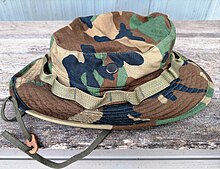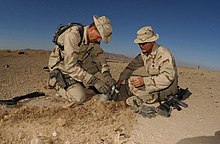
A slouch hat is a wide-brimmed felt or cloth hat most commonly worn as part of a military uniform, often, although not always, with a chinstrap. It has been worn by military personnel from many different nations including Australia, Ireland, the United Kingdom, Canada, India, New Zealand, Southern Rhodesia, France, the United States, the Confederate States, Germany and many others. Australia and New Zealand have had various models of slouch hat as standard issue headwear since the late Victorian period.

The Battle Dress Uniform (BDU) is a camouflaged combat uniform that was used by the United States Armed Forces as their standard combat uniform from the early 1980s to the mid-2000s. Since then, it has been replaced or supplanted in every branch of the U.S. Armed Forces.

The M1 helmet is a combat helmet that was used by the U.S. military from World War II until 1985, when it was succeeded by the PASGT helmet. The M1 helmet has become an icon of the US military, with its design inspiring other militaries around the world.

A combat uniform, also called field uniform, battledress or military fatigues, is a casual type of uniform used by military, police, fire and other public uniformed services for everyday fieldwork and combat duty purposes, as opposed to dress uniforms worn in functions and parades. It generally consists of a jacket, trousers and shirt or T-shirt, all cut to be looser and more comfortable than more formal uniforms. Design may depend on regiment or service branch, e.g. army, navy, air force, marines, etc. In the army branches, fabrics tend to come in camouflage, disruptive pattern or else green, brown or khaki monochrome, in order to approximate the background and make the soldier less visible in nature. In Western dress codes, field uniform is considered equivalent to civilian casual wear. As such, field uniform is considered less formal than service dress uniform, generally aimed at office or staff use, as well as mess dress uniform, and full dress uniform.

The U.S. Army's M1943 uniform was a combat uniform manufactured in windproof cotton sateen cloth introduced in 1943 to replace a variety of other specialist uniforms and some inadequate garments, like the M1941 Field Jacket. It was used through the remainder of World War II and into the Korean War with modifications before being replaced by the OG-107 uniform beginning in 1952.
The United States Army in World War II used a variety of standard and non-standard dress and battle uniforms, which often changed depending upon the theater of war, climatic environment, and supply exigencies.

Disruptive Pattern Camouflage Uniform (DPCU), also nicknamed Auscam, jelly bean camo, or hearts and bunnies is a five-colour military camouflage pattern used by the Australian Defence Force. Replacing the jungle greens used from WWII, it was developed and tested during the late 1970s and early 1980s. The uniform was trialled in 1987, with it being slowly introduced in late 1989, with the last production and discontinuation of the jungle greens being in late 1990. Jungle greens were last issued in late 1991 for Australian Regular Army, and late 1994 for Australian Army Reserve.

Tiger stripe is the name of a group of camouflage patterns developed for close-range use in dense jungle during jungle warfare by the South Vietnamese Armed Forces and adopted in late 1962 to early 1963 by US Special Forces during the Vietnam War. During and after the Vietnam War, the pattern was adopted by several other Asian countries. It derives its name from its resemblance to a tiger's stripes and were simply called "tigers." It features narrow stripes that look like brush-strokes of green and brown, and broader brush-strokes of black printed over a lighter shade of olive or khaki. The brush-strokes interlock rather than overlap, as in French Lizard pattern (TAP47) from which it apparently derives.

The Airman Battle Uniform (ABU) is a U.S. camouflage combat uniform formerly worn by members of the United States Air Force, United States Space Force, and some civilian employees of the U.S. Department of the Air Force until April 2021. It replaced the Battle Dress Uniform and Desert Camouflage Uniform on 1 November 2011 after a four-year phase-in period.

The jeep cap, sometimes referred to as the jeep hat, originally the US Army issued Cap, Wool, Knit, M1941 is a knit cap with a short visor made mostly from knitted yarn, originally wool, but now typically acrylic. Also sometimes referred to as a "skull cap" due to its popularity with skateboarders, or a "Radar cap" due to the cap being made famous by the character Radar O'Reilly from the hit US TV sitcom M*A*S*H.

The ERDL pattern, also known as the Leaf pattern, is a camouflage pattern developed by the United States Army at its Engineer Research & Development Laboratories (ERDL) in 1948. It was not used until the Vietnam War, when it was issued to elite reconnaissance and special operations units beginning early 1967.
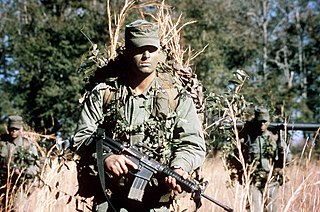
A patrol hat, also known as a field cap, is a soft kepi constructed similarly to a baseball cap, with a stiff, rounded visor but featuring a flat top, worn by military personnel of some countries in the field when a combat helmet is not required.

The utility cover, also known as the utility cap and eight-pointed cover, is the United States Marine Corps cap, worn with their combat utility uniform. It is an eight-pointed hat, with a visor similar to a baseball cap. It is worn "blocked", that is, creased and peaked, for a sharper appearance. A version is also worn as part of the U.S. Navy's Navy Working Uniform.

The following is a general overview of the Heer main uniforms, used by the German Army prior to and during World War II.
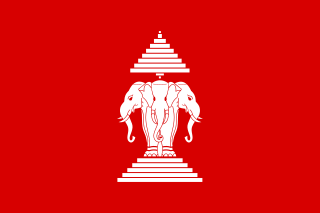
The Royal Lao Army, also designated by its anglicized title RLA, was the Land Component of the Royal Lao Armed Forces (FAR), the official military of the Kingdom of Laos during the North Vietnamese invasion of Laos and the Laotian Civil War between 1960 and 1975.

The OG-107 was the basic work utility uniform (fatigues) of all branches of the United States Armed Forces from 1952 until its discontinuation in 1989. The designation came from the U.S. Army's coloring code "Olive Green 107", which was the shade of dark green used on the original cotton version of the uniform. The OG-107 was superseded by the Battle Dress Uniform (BDU) throughout the 1980s, and was also used by several other countries, including ones that received military aid from the United States.
Each branch of the Confederate States armed forces had its own service dress and fatigue uniforms and regulations regarding them during the American Civil War, which lasted from April 12, 1861, until May 1865.
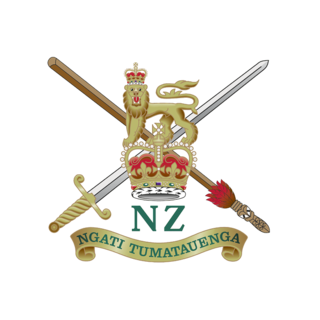
The New Zealand Army uniform has changed over the years from that of the original Armed Constabulary of the 1800s to the modern Army Combat Uniform style in use by the majority of world armies today. While British Army influence has always been strong, distinctive New Zealand features have gradually developed. From 2013 the New Zealand Army uniform underwent a complete redesign with a new and distinctive camouflage pattern unique to the NZDF.

The Frog Skin, also known as Duck Hunter, is a battledress camouflage pattern with mottle and disruptive coloration to blend into the environment similar to a frog's crypsis skin.
The uniforms of the Australian Army have changed significantly over the past century, although the accoutrements worn over this period have remained relatively similar. The forces of the Australian colonies and the early forces of the Commonwealth post-Federation in 1901 closely followed the uniforms of the British Army. Since then it has continued to be influenced by British but also US styles, as well as including some distinctly Australian designs, reflecting local conditions and trends.
